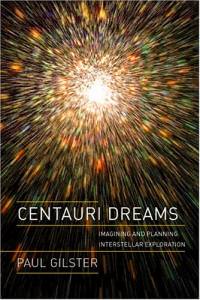Host: Fraser Cain (@fcain)
Special Guest: Bas Lansdorp, CEO of Mars One
Guests:
Morgan Rehnberg (cosmicchatter.org / @MorganRehnberg )
Brian Koberlein (@briankoberlein)
Alessondra Springmann (@sondy)
Dave Dickinson (@astroguyz / www.astroguyz.com)
Continue reading “Weekly Space Hangout – April 24, 2015: Bas Lansdorp, CEO of Mars One”
Scientists Map the Dark Matter Around Millions of Galaxies
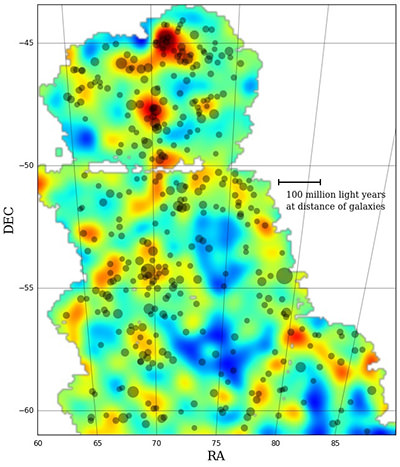
This week, scientists with the Dark Energy Survey (DES) collaboration released the first in a series of detailed maps charting the distribution of dark matter inferred from its gravitational effects. The new maps confirm current theories that suggest galaxies will form where large concentrations of dark matter exist. The new data show large filaments of dark matter where visible galaxies and galaxy clusters lie and cosmic voids where very few galaxies reside.
“Our analysis so far is in line with what the current picture of the universe predicts,” said Chihway Chang from the Swiss Federal Institute of Technology (ETH) in Zurich, a co-leader of the analysis. “Zooming into the maps, we have measured how dark matter envelops galaxies of different types and how together they evolve over cosmic time.”
The research and maps, which span a large area of the sky, are the product of a massive effort of an international team from the US, UK, Spain, Germany, Switzerland, and Brazil. They announced their new results at the American Physical Society (APS) meeting in Baltimore, Maryland.
According to cosmologists, dark matter particles stream and clump together over time in particular regions of the cosmos, often in the same places where galaxies form and cluster. Over time, a “cosmic web” develops across the universe. Though dark matter is invisible, it expands with the universe and feels the pull of gravity. Astrophysicists then can reconstruct maps of it by surveying millions of galaxies, much like one might infer the shifting orientation of a flock of birds from its shadow moving along the ground.
DES scientists created the maps with one of the world’s most powerful digital cameras, the 570-megapixel Dark Energy Camera (DECam), which is particularly sensitive to the light from distant galaxies. It is mounted on the 4-meter Victor M. Blanco Telescope, located at the Cerro Tololo Inter-American Observatory in northern Chile. Each of its images records data from an area 20 times the size of the moon as seen from earth.
In addition, DECam collects data nearly ten times faster than previous machines. According to David Bacon, at the University of Portsmouth’s Institute of Cosmology and Gravitation, “This allows us to stare deeper into space and see the effects of dark matter and dark energy with greater clarity. Ironically, although these dark entities make up 96% of our universe, seeing them is hard and requires vast amounts of data.”
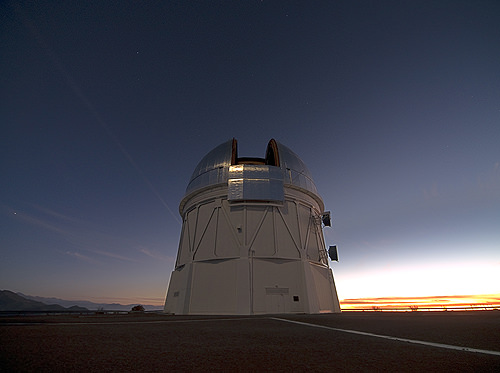
The telescope and its instruments enable precise measurements utilizing a technique known as “gravitational lensing.” Astrophysicists study the small distortions and shear of images of galaxies due to the gravitational pull of dark matter around them, similar to warped images of objects in a magnifying glass, except that the lensed galaxies observed by the DES scientists are at least 6 billion light-years away.
Chang and Vinu Vikram (Argonne National Laboratory) led the analysis, with which they traced the web of dark matter in unprecedented detail across 139 square degrees of the southern hemisphere. “We measured the barely perceptible distortions in the shapes of about 2 million galaxies to construct these new maps,” Vikram said. This amounts to less then 0.4% of the whole sky, but the completed DES survey will map out more than 30 times this area over the next few years.
They submitted their research paper for publication in an upcoming issue of the Monthly Notices of the Royal Astronomical Society, and the DES team publicly released it as part of a set of papers on the arXiv.org server on Tuesday.
The precision and detail of these large contiguous maps being produced by DES scientists will allow for tests of other cosmological models. “I’m really excited about what these maps will tell us about dark matter in galaxy clusters especially with respect to theories of modified gravity,” says Robert Nichol (University of Portsmouth). Einstein’s model of gravity, general relativity, could be incorrect on large cosmological scales or in the densest regions of the universe, and ongoing research with the Dark Energy Survey will facilitate investigations of this.
How Do We Know Dark Energy Exists?
We have no idea what it dark energy is, so how are we pretty sure it exists?
I’ve talked about how astronomers know that dark matter exists. Even though they can’t see it, they detect it through the effect its gravity has on light. Dark matter accounts for 27% of the Universe, dark energy accounts for 68% of the Universe. And again, astronomers really have no idea what what it is, only that they’re pretty sure it does exist. 95% of the nature of the Universe is a complete and total mystery. We just have no idea what this stuff is.
So this time around, lets focus on dark energy. Back in the late 90s, astronomers wanted to calculate once and for all if the Universe was open or closed. In other words, they wanted to calculate the rate of expansion of the Universe now and then compare this rate to its expansion in the past. In order to answer this question, they searched the skies for a special type of supernova known as a Type 1a.
While most supernovae are just massive stars, Type 1a are white dwarf stars that exist in a binary system. The white dwarf siphons material off of its binary partner, and when it reaches 1.6 times the mass of the Sun, it explodes. The trick is that these always explode with roughly the same amount of energy. So if you measure the brightness of a Type 1a supernova, you know roughly how far away it is.
Astronomers assumed the expansion was slowing down. But the question was, how fast was it slowing down? Would it slow to a halt and maybe even reverse direction? So, what did they discover?
In the immortal words of Isaac Asimov, “the most exciting phrase to hear in science, the one that heralds new discoveries, is not ‘Eureka’, but ‘That’s Funny’” Instead of finding that the expansion of the Universe was slowing down, they discovered that it’s speeding up. That’s like trying to calculate how quickly apples fall from trees and finding that they actually fly off into the sky, faster and faster.
Since this amazing, Nobel prize winning discovery, astronomers have used several other methods to verify this mind-bending reality of the Universe. NASA’s Wilkinson Microwave Anisotropy Probe studied the Cosmic Microwave Background Radiation of the Universe for 7 years, and put the amount of dark energy at 72.8% of the Universe. ESA’s Planck spacecraft performed an even more careful analysis and pegged that number at 68.3% of the Universe.

Astronomers know that dark energy exists. There are multiple lines of evidence. But as with dark matter, they have absolutely no clue what it is. Einstein described an idea he called the cosmological constant. It was a way to explain a static Universe that really should be expanding or contracting. Once astronomers figured out the Universe was actually expanding, he threw the idea out.
Hey, not so fast there “Einstein”. Maybe just one of the features of space itself is that it pushes stuff away. And the more space there is, the more outward pressure you get. Perhaps from virtual particles popping in and out of existence in the vacuum of space.
Another possibility is a phenomenon called Quintessence, a negative energy field that pervades the entire Universe. Yes, that sounds totally woo-woo, thanks Universe, Deepak Chopra crazy talk, but it might explain the repulsive force that makes up most of the Universe. And there are other theories, which are even more exotic. But mostly likely it’s something that physicists haven’t even thought of yet.
So, how do we know dark energy exists? Distant supernovae are a lot further away from each other than they should be if the expansion of the Universe was slowing down. Nobody has any idea what it is, it’s a mystery, and there’s nothing wrong with a mystery. In fact, for me, it’s one of the most exciting ideas in space and astronomy.
What do you think dark energy is?
How Do We Know Dark Matter Exists?
Dark matter can’t be seen or detected by any of our instruments, so how do we know it really exists?
Imagine the Universe was a pie, and you were going to slice it up into tasty portions corresponding to what proportions are what. The largest portion of the pie, 68% would go to dark energy, that mysterious force accelerating the expansion of the Universe. 27% would go to dark matter, the mysterious matter that surrounds galaxies and only interacts through gravity. A mere 5% of this pie would go to regular normal matter, the stuff that stars, planets, gas, dust, and humans are made out of.
Dark matter has been given this name because it doesn’t seem to interact with regular matter in any way. It doesn’t collide with it, or absorb energy from it. We can’t see it or detect it with any of our instruments. We only know it’s there because we can see the effect of its gravity.
Now, you might be saying, if we don’t know what this thing is, and we can’t detect it. How do we know it’s actually there? Isn’t it probably not there, like dragons? How do we know dark matter actually exists, when we have no idea what it actually is?
Oh, it’s there. In fact, pretty much all we know is that it does exist. Dark matter was first theorized back in the 1930s by Fritz Zwicky to account for the movement of galaxy clusters, but the modern calculations were made by Vera Rubin in the 1960s and 70s. She calculated that galaxies were spinning more quickly than they should. So quickly that they should tear themselves apart like a merry-go-round ejecting children.
Rubin imagined that every galaxy was stuck inside a vast halo of dark matter that supplied the gravity to hold the galaxy together. But there was no way to actually detect this stuff, so astronomers proposed other models. Maybe gravity doesn’t work the way we think it does at vast distances.
But in the last few years, astronomers have gotten better and better at detecting dark matter, purely though the effect of its gravity on the path that light takes as it crosses the Universe. As light travels through a region of dark matter, its path gets distorted by gravity. Instead of taking a straight line, the light is bent back and forth depending on how much dark matter is passes through.
And here’s the amazing part. Astronomers can then map out regions of dark matter in the sky just by looking at the distortions in the light, and then working backwards to figure out how much intervening dark matter would need to be there to cause it.
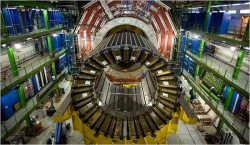
These techniques have become so sophisticated that astronomers have discovered unusual situations where galaxies and their dark matter have gotten stripped away from each other. Or dark matter galaxies which don’t have enough gas to form stars. They’re just giant blobs of dark matter. Astronomers even use dark matter as gravitational lenses to study more distant objects. They have no idea what dark matter is, but they can still use it as a telescope.
They’ve never captured a dark matter particle, and haven’t studied them in the lab. One of the Large Hadron Collider’s next tasks will be to try and generate particles that match the characteristics of dark matter as we understand it. Even if the LHC doesn’t actually create dark matter, it will help narrow down the current theories, hopefully helping physicists focus in on the true nature of this mystery.
This is how science works. Someone notices something unusual, and then people propose theories to explain it. The theory that best matches reality is considered correct. We live in a modern world, where so many scientific theories have already been proven for hundreds of years: germs, gravity, evolution, etc. But with dark matter, you’re alive at a time when this is a mystery. And if we’re lucky, we’ll see it solved within our lifetime. Or maybe there’s no dark matter after all, and we’re about to learn something totally new about our Universe. Science, it’s all up to you.
What do you think dark matter is? Tell us in the comments below.
Weekly Space Hangout – February 13, 2015 – Paul Gilster and his “Centauri Dreams”
Host: Fraser Cain (@fcain)
Special Guest: Paul Gilster (centauri-dreams.org / @centauri_dreams),author of “Centauri Dreams”
Guests:
Morgan Rehnberg (cosmicchatter.org / @MorganRehnberg )
Dave Dickinson (@astroguyz / www.astroguyz.com)
Brian Koberlein (@briankoberlein)
This Week’s Stories:
SpaceX news
A (very!) salty ocean for Enceladus?
Cassini begins a year of moon imaging
The February ‘Black Moon’
The Number of Reachable Asteroids has Doubled
Stars formed earlier than we thought
Dark matter seen in center of Milky Way
Neil Armstrong Had a Man Purse and It Was Full of Awesome Stuff From His Moon Trip
Lunar Surface Flown Apollo 11 Artifacts From the Neil Armstrong Estate on loan to the Smithsonian’s National Air and Space Museum, Washington D.C.
Pad 39B to Gain New Flame Deflector and Trench Upgrade
Japan’s Akatsuki Spacecraft to Make Second Attempt to Enter Orbit of Venus in December, 2015
Dark Matter Could Create Halos of Light Around Galaxies
NASA, Space Station Partners Announce Future Mission Crew Members
Has Galaxy X Been Found?
Total Solar Eclipse on March 20, 2015
Europe’s Experimental Mini-Space Shuttle Launch
NASA Titan Submarine Concept
Cassini Data Indicates Enceladus’ Ocean Similar to Soda Lakes on Earth
Russia Steps Up as UAE Launched New Space Agency
Surprise! Earth’s Core has a Core
SDO Turns 5!
Astronomers Capture Birth of Multiple Star System
DARPA to Begin Testing Satellite-Launching Fighter Jet This Year
Dark Matter Exists in the Inner Parts of Our Galaxy
Titan Flyby (T-109): Mapping Titan’s North Pole in Infrared
The Hunt for Gravitational Waves Could Be Nearing Success
Twinkle Twinkle Little Exoplanet [hunter]
Future Space Station Crew Dons Jedi Robes for Star Wars-Inspired Poster
We record the Weekly Space Hangout every Friday at 12:00 pm Pacific / 3:00 pm Eastern. You can watch us live on Google+, Universe Today, or the Universe Today YouTube page.
You can join in the discussion between episodes over at our Weekly Space Hangout Crew group in G+, and suggest your ideas for stories we can discuss each week!
How Fast is the Universe Expanding?
The Universe is expanding, but how quickly is it expanding? How far away is everything getting from everything else? And how do we know any of this anyway?
When astronomers talk about the expansion of the Universe, they usually express it in terms of the Hubble parameter. First introduced by Edwin Hubble when he demonstrated that more distant galaxies are moving away from us faster than closer ones.The best measurements for this parameter gives a value of about 68 km/s per megaparsec.
Let’s recap. Hubble. Universe. Galaxies. Leaving. Further means faster. And then I said something that sounded like “blah blah Lando blah blah Kessel Run 68 km/s per megaparsec”. Which translates to if you have a galaxy 1 megaparsec away, that’s 3.3 million light years for those of you who haven’t seen Star Wars, it would be expanding away from us at a speed of 68 km/s. So, 1 megaparsec in distance means it’s racing away at 68 km/s.
This is all because space is expanding everywhere in all places, and as a result distant galaxies appear to be expanding away from us faster than closer ones. There’s just more “space” to expand between us and them in the first place. Even better, our Universe was much more dense in the past, as a result the Hubble parameter hasn’t always had the same value.
There are two things affecting the Hubble parameter: dark energy, working to drive the Universe outwards, and matter, dark and regular flavor trying to hold it together. Pro tip: The matter side of this fight is currently losing.

Earlier in the Universe, when the Hubble parameter was smaller, matter had a stronger influence due to its higher overall density. Today dark energy is dominant, thus the Hubble parameter is larger, and this is why we talk about the Universe not only expanding but accelerating.
Our cosmos expands at about the rate at which space is expanding, and the speed at which objects expand away from us depends upon their distance. If you go far enough out, there is a distance at which objects are speeding away from us faster than the speed of light. As a result, it’s suspected that receding galaxies will cross a type of cosmological event horizon, where any evidence of their existence, not even light, would ever be able to reach us, no matter how far into the future you went.
What do you think? Is there anything out there past that cosmological event horizon line waiting to surprise us?
What is Gravitational Lensing?
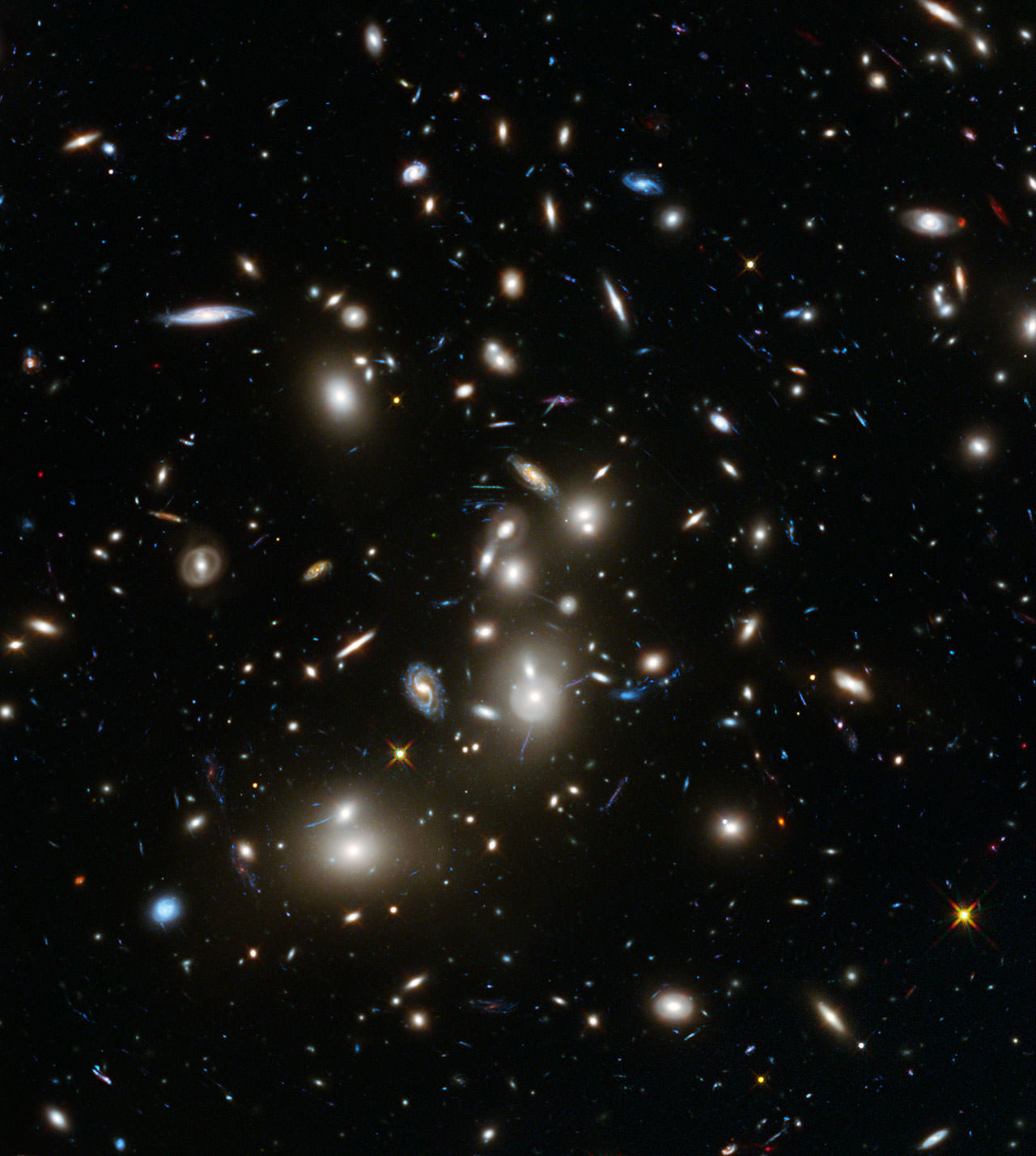
Gravity’s a funny thing. Not only does it tug away at you, me, planets, moons and stars, but it can even bend light itself. And once you’re bending light, well, you’ve got yourself a telescope.
Everyone here is familiar with the practical applications of gravity. If not just from exposure to Loony Tunes, with an abundance of scenes with an anthropomorphized coyote being hurled at the ground from gravitational acceleration, giant rocks plummeting to a spot inevitably marked with an X, previously occupied by a member of the “accelerati incredibilus” family and soon to be a big squish mark containing the bodily remains of the previously mentioned Wile E. Coyote.
Despite having a very limited understanding of it, Gravity is a pretty amazing force, not just for decimating a infinitely resurrecting coyote, but for keeping our feet on the ground and our planet in just the right spot around our Sun. The force due to gravity has got a whole bag of tricks, and reaches across Universal distances. But one of its best tricks is how it acts like a lens, magnifying distant objects for astronomy.
Continue reading “What is Gravitational Lensing?”What Is The Biggest Thing in The Universe?
Think big. Really big. Like, cosmic big. How big can things in the Universe get? Is a galaxy big? What about a supercluster? What is the biggest thing in the Universe?
Our observable Universe is a sphere 96 billion light-years across, and the entire Universe might be infinite in size. Which is a hoarders dream walk-in closet space stuffed full of “things”. It’s loaded down with so much stuff, we’ve even given up naming things individually and now just spew out a list of letters and numbers to try and keep track of it all.
So, as is traditional, in a fit of adolescent OCD and one-upmanship reserved generally for things like tanks, planes and guns, we’re drawn to the question… What’s the biggest thing in the Universe. Well, 14 year old Fraser Cain, put down your copy of “Weapons and Warfare Volume 3” which you picked up at the dollar store as part of an incomplete set, as this is going to get a little tricky.
It all depends on what you mean by a “thing”. The biggest physical object is probably a star. The largest possible red giant star could be as big as 2,100 times the size our Sun. Placed inside our own Solar System, a monster star like this would extend out past the orbit of Saturn. That’s big, but we might be able to get even bigger if we’re willing to get past the idea that a “thing” has to be a homogeneous physical object.
Consider the regions around supermassive black holes. Within our own galaxy, things are pretty quiet, but around actively feeding black holes, there can be disks of material with such temperature and density that they act like the core of a star, fusing hydrogen into helium. Which, purely based on high volumetric density of pure awesome, I’m going to call a thing. An accretion disk around a quasar could be light days across, extending well past the orbit of Pluto and killing us all, if you dumped it in our Solar System.
If we’re going to be all philosophical about what constitutes a “thing” and you’re not all fussy about physical structure and just want a collection of material held together by gravity, then we can really can make some leaps and bounds in our “who’s got the biggest” measuring contest. Our own galaxy extends up to 120,000 light-years across.
There are much larger galaxies, ones that make the Milky Way look like that cat leash pendant from Men In Black 2. And ours is just one contained within a much larger cluster of galaxies known, rather unimaginatively, as the Local Group. Don’t let the centrist name fool you, this cluster contains around 50 galaxies and measures more than 10 million light-years across.
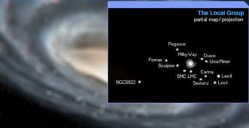
And we’re just getting started. The Local Group is one part of the Virgo Supercluster. A massive galactic structure that measures 110 million light-years apart. In 2014, astronomers announced that the Virgo Supercluster is just one lobe of an even larger structure, beautifully known as Laniakea, or “Immeasurable heaven” in Hawaiian. The name originated from Nawa’a Napoleon, an associate professor of Hawaiian Language at Kapiolani Community College. It honors the Polynesian sailors using “heavenly knowledge” navigating the Pacific Ocean, reminding us that romance is still alive and well in space and astronomy. Laniakea is centered around the Great Attractor – a mysterious source of gravity drawing galaxies towards it.
I almost forgot about our size contest. So who’s got the biggest space thing? According to buzzkill Ethan Siegel from the Starts With a Bang blog, you can’t actually have a structure that’s as big as Laniakea, and call it a thing. The fine-print reality is that the expansion of the Universe is being accelerated by dark energy. These galaxies are being pushed apart by dark energy faster than gravity can pull them together. So they’d never be able to form into a single object given enough time.
In other words, the largest possible object is a collection of galaxies at the exact size where gravity is just strong enough to overcome the expansive force of dark energy. Beyond that, everything’s getting spread apart, and it’s for our purposes we’re actually going to draw a line and say it’s not quite right to call it a thing. Unless you’d suggest a giant expanse of nothing is a thing… but let’s save that for another episode.
So what do you think? Do you feel like it’s right to call superclusters like Laniakea “a structure”?
NASA’s NuSTAR Scans the Sun with X-ray Vision

What if you had x-ray vision like Superman? Or if those funny-looking glasses they advertised in comic books in the 60s actually worked?* Then with those our Sun might look something like this, lighting up with brilliant flares of high-energy x-rays as seen by NASA’s super-sensitive NuSTAR Space Telescope (with a little help from SDO.)
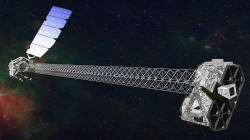
Of course NASA’s orbiting NuSTAR x-ray telescope is not like a typical medical imaging system. Instead of looking for broken bones, NuSTAR (short for Nuclear Spectroscopic Telescope Array) is made to detect high-energy particles blasting across the Universe from exotic objects like supermassive black holes, pulsars, and supernovae.
Read more: Stars Boil Before They Blow Up, Says NuSTAR
But astronomers suggested turning NuSTAR’s gaze upon our own Sun to see what sorts of x-ray activity may be going on there.
“At first I thought the whole idea was crazy,” said Fiona Harrison, a Professor of Physics and Astronomy at Caltech and PI for the NuSTAR mission. “Why would we have the most sensitive high energy X-ray telescope ever built, designed to peer deep into the universe, look at something in our own back yard?”
As it turns out NuSTAR was able to reveal some very interesting features on the Sun, showing where the corona is being heated to very high temperatures. The image above shows NuSTAR’s first observations, overlaid onto data acquired by NASA’s Solar Dynamics Observatory.
NuSTAR data is shown in green and blue, revealing high-energy emission around – but not exactly aligned with – active regions on the Sun where solar plasma is being heated to more than 3 million degrees. The red represents ultraviolet light captured by SDO and shows material in the solar atmosphere at a slightly cooler 1 million degrees.
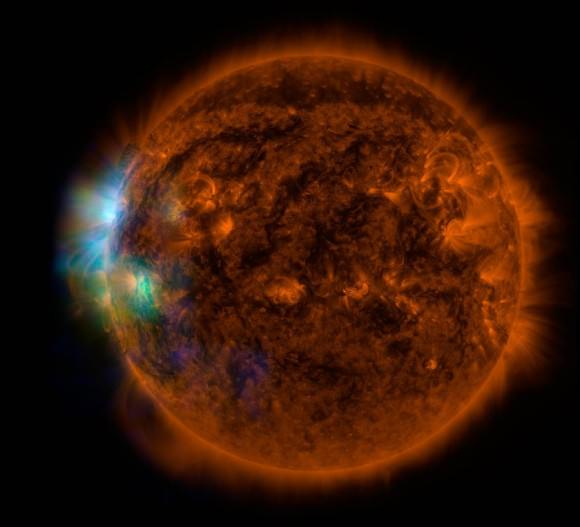
Because the Sun isn’t terribly intense in high energy x-ray output it’s safe to observe it with NuSTAR — it’s not likely to burn out the telescope’s sensors. But what NuSTAR can detect may help astronomers determine the exact mechanisms behind the intense coronal heating that occurs in and above the Sun’s chromosphere. If so-called “nanoflares” — miniature and as-yet-invisible versions of solar flares — are responsible, for instance, NuSTAR might be able to catch them in action for the first time.
Read more: Warm Coronal Loops May Hold the Key to Hot Solar Atmosphere
“NuSTAR will be exquisitely sensitive to the faintest X-ray activity happening in the solar atmosphere, and that includes possible nanoflares,” said David Smith, solar physicist and member of the NuSTAR team at the University of California, Santa Cruz.
In addition NuSTAR could potentially detect the presence of axions in the Sun’s core — hypothesized particles that may make up dark matter in the Universe.
NuSTAR may not be a “solar telescope” per se, but that won’t stop astronomers from using its unique abilities to learn more about the star we intimately share space with.
“NuSTAR will give us a unique look at the Sun, from the deepest to the highest parts of its atmosphere.”
– David Smith, solar physicist, University of California Santa Cruz
Read more in a JPL article here.
*I never did get my box of 100 army men, either. Then again, I may have ordered a few decades too late.
Weekly Space Hangout – Dec. 19, 2014: Methane on Mars!
Host: Fraser Cain (@fcain)
Guests:
Morgan Rehnberg (cosmicchatter.org / @cosmic_chatter)
Ramin Skibba (@raminskibba)
Alessondra Springmann (@sondy)
Continue reading “Weekly Space Hangout – Dec. 19, 2014: Methane on Mars!”



